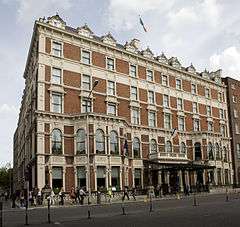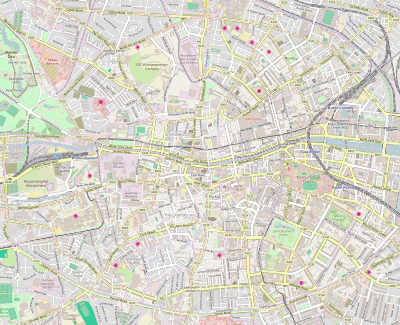Shelbourne Hotel
The Shelbourne Hotel is a historic hotel in Dublin, Ireland, situated in a landmark building on the north side of St Stephen's Green. Currently owned by Kennedy Wilson[1] and operated by Marriott International, the hotel has 265 rooms in total and reopened in March 2007 after undergoing an eighteen-month refurbishment.
| Shelbourne Hotel | |
|---|---|
 The Shelbourne Hotel, August 2008 | |
 | |
| General information | |
| Status | Open |
| Type | Hotel |
| Address | 27 St Stephen's Green |
| Town or city | Dublin |
| Country | Republic of Ireland |
| Coordinates | 53.33893°N 6.256092°W |
| Elevation | 18 m (59 ft) |
| Named for | William Petty, 2nd Earl of Shelburne |
| Opened | 1824 |
| Owner | Marriott International |
| Technical details | |
| Floor count | 6 |
| Design and construction | |
| Architect | John McCurdy |
| Other information | |
| Number of rooms | 265 |
| Website | |
| theshelbourne | |
History
The Shelbourne Hotel was founded in 1824 by Martin Burke, a native of Tipperary, when he acquired three adjoining townhouses overlooking Stephen's Green, Europe's largest garden square. Burke named his grand new hotel The Shelbourne, after William Petty, 2nd Earl of Shelburne.[2] William Makepeace Thackeray was an early guest, staying in 1842 and including a piece about the Shelbourne in The Irish Sketch-Book (1843).[3]
In the early 1900s, Alois Hitler jr., the elder half-brother of Adolf Hitler, worked in the hotel while in Dublin.[4]
During the 1916 Easter Rising the hotel was occupied by 40 British troops under Captain Andrews to counter the Irish Citizen Army and Irish Volunteer forces, commanded by Michael Mallin, who had occupied Stephen's Green.[2] In 1922, the Constitution of the Irish Free State was drafted in room 112, now known as The Constitution Room.[5]
The facade was refurbished in 2016, winning an award from the Irish Georgian Society.[6] In December 2018 UEFA's executive committee made the draw for the 2019 UEFA Nations League Finals in the hotel.[7]
Statues
A major redesign by John McCurdy was completed in 1867, with the Foundry of Val d'Osne casting the four external caryatid style torchère statues. These were based on two repeated beaux-arts neoclassical models originally sculpted by the prolific French sculptor Mathurin Moreau entitled Égyptienne - the two female Ancient Egyptian[8] figures flanking either side of the front door, and Négresse - the two female ancient Kushite (Nubian)[9] figures flanking either corner of the main building. All four statues are wearing gold coloured anklets, and are draped, with jewellery picked out in gilt while supporting a torch with a frosted glass flambeau shade.[10][11][12] All four statues are on a circular base with a further square metal plinth with cartouches to the angles indicating royal descent.[13]
In feint writing at the front of the circular base of all four statues can be seen the name of the foundry which produced the statues Val d'Osne. Of the several other examples of the castings, the most notable can be seen in the porch of the Hôtel de ville (town hall) in the French town of Remiremont as well as outside the mausoleum of the architect Temple Hoyne Buell[14][15] in Denver, Colarado and in the Jardins do Palácio de Cristal in Porto.[16][17][18] In all three cases the door is flanked either side by one Égyptienne and one Négresse statue indicating parity.
In July 2020, the statues at the front of the building were removed by management as a precautionary response to the toppling and removal of statues following on from the killing of George Floyd and Black Lives Matter protests. This move resulted from the mistaken belief that either two or all four of the statues represented nubian slaves shown in manacles.[19] Both histories of the Hotel by Elizabeth Bowen (1951) and Michael O'Sullivan (1999) state that two of the statues represent slaves or servants with Bowen stating "on each stands a female statue, Nubian in aspect, holding a torch shaped lamp. Two of the four are princesses; two are slave girls". Neither book notes the source of the information and neither book cites the original catalogue or primary sources.[20] Other references to castings of the statues have cited them incorrectly alternatively as Egyptian and Greek godesses.[21] Kyle Leyden, an art history lecturer at the University of London, indicated that the statues did not depict slaves as claimed, but rather aristocratic women of Egypt and Africa.[22]
Following the removal of the statues the matter was referred by the Irish Georgian Society to the Planning Enforcement Section of Dublin City Council for investigation.[23]
Gallery
- The first of two Négresse neoclassical beaux-arts statues, originally sculpted by Mathurin Moreau shown with gold coloured headband, gold coloured anklets and with elaborate robe detailing[10][11]
- The second of two Négresse statues shown with gold coloured headband, gold coloured anklets and with elaborate robe detailing
.jpg) The first of two beaux-arts Égyptienne statues shown with gold anklets, a gold snake emblem clasp on the forehead and gold snake emblem earrings, elaborate collar and headress and with ancient Egyptian Hieroglyphics on the front of the robe
The first of two beaux-arts Égyptienne statues shown with gold anklets, a gold snake emblem clasp on the forehead and gold snake emblem earrings, elaborate collar and headress and with ancient Egyptian Hieroglyphics on the front of the robe- The second of two beaux-arts Égyptienne statues shown with gold anklets, a gold snake emblem clasp on the forehead and gold snake emblem earrings, elaborate collar and headress and with ancient Egyptian Hieroglyphics on the front of the robe
Popular culture
| Wikimedia Commons has media related to Shelbourne Hotel. |
In James Joyce's Ulysses, Leopold Bloom remembers the Shelbourne as where "Mrs Miriam Dandrade", a "Divorced Spanish American" sold him "her old wraps and black underclothes".[24]
Notable staff
In the early 1900s, Alois Hitler jr., the elder half-brother of Adolf Hitler, worked in the hotel while in Dublin.[25]
References
- "Shelbourne Hotel | Kennedy Wilson". www.kennedywilson.com. Retrieved 29 July 2020.
- O'Sullivan 1999
- "1867 – Shelbourne Hotel, St. Stephen's Green, Dublin", Archiseek, Dublin
- "Paddy, Bridget and Uncle Adolf — meet the Irish Hitlers". Irish Independent. 2012-02-26. Retrieved 2016-10-31.
- Lyons, Tom; McConnell, Daniel (12 February 2012). "FG insider briefs the top bankers at private dinner: Cox marks the card of corporate elite on crisis". Irish Independent. Retrieved 31 July 2017.
- Cousins, Robbie (13 October 2017). "Shelbourne Hotel Restoration Wins Irish Georgian Society Architectural Conservation Award 2017". Construction. Retrieved 29 July 2020.
- "UEFA Executive Committee agenda for Dublin meeting". UEFA.com. 16 November 2018. Retrieved 28 July 2020.; "UEFA Nations League Finals draw". UEFA.com. 3 December 2018. Retrieved 28 July 2020.
- McGreevy, Ronan. "Shelbourne Hotel removes 153-year-old statues of slave girls from its plinth". The Irish Times. Retrieved 29 July 2020.
- Fritz Gubler; Raewyn Glynn (2008). Great, Grand & Famous Hotels. Great, Grand & Famous Hotels. p. 128. ISBN 978-0-9804667-0-6.
- "VO_PL370_63 – Candélabre Egyptienne, VO_PL370_64 – Candélabre Négresse". e-monumen.net. Retrieved 29 July 2020.
- "Torchères (2) – Shelbourne Hotel – Dublin". e-monumen.net (in French). Retrieved 29 July 2020.
- "A pair of French bronze-patinated cast-iron figural torcheres, entitled 'Negresse' and 'Egyptienne' , CAST BY VAL D'OSNE, AFTER MODELS BY MATHURIN MOREAU, LATE 19TH/EARLY 20TH CENTURY". www.christies.com. Retrieved 29 July 2020.
- "A pair of French bronze-patinated cast-iron figural torcheres, entitled 'Negresse' and 'Egyptienne'". Barnebys.co.uk. Retrieved 29 July 2020.
- "The Maker of the Modern Mall". Gravely Speaking. 2 May 2015. Retrieved 30 July 2020.
- "Temple Hoyne Buell - Denver, CO - Mausoleums on Waymarking.com". www.waymarking.com. Retrieved 30 July 2020.
- "L'Egyptienne – Jardins do Palácio de Cristal – Porto". e-monumen.net (in French). Retrieved 30 July 2020.
- "Paire de torchères – Remiremont". e-monumen.net (in French). Retrieved 29 July 2020.
- "La fonte d art haut-marnaise - PDF Free Download". docplayer.fr. Retrieved 30 July 2020.
- Lynott, Laura. "Statues of Slaves Removed from Outside Shelbourne Hotel". Irish Independent. Retrieved 29 July 2020.
- "The Shelbourne by Elizabeth Bowen". googlebooks.com. 1951. Retrieved 29 July 2020.
- "The Maker of the Modern Mall". Gravely Speaking. 2 May 2015. Retrieved 30 July 2020.
- McGreevy, Ronan (31 July 2020). "Shelbourne Hotel statues do not depict slave girls, says leading art historian". The Irish Times. Retrieved 31 July 2020.
- Kilraine, John. "Council Investigates Removal of Statues from Shelbourne Hotel". RTE. RTE. Retrieved 29 July 2020.
- Ulysses 15.2994
- "Paddy, Bridget and Uncle Adolf — meet the Irish Hitlers". Irish Independent. 2012-02-26. Retrieved 2016-10-31.